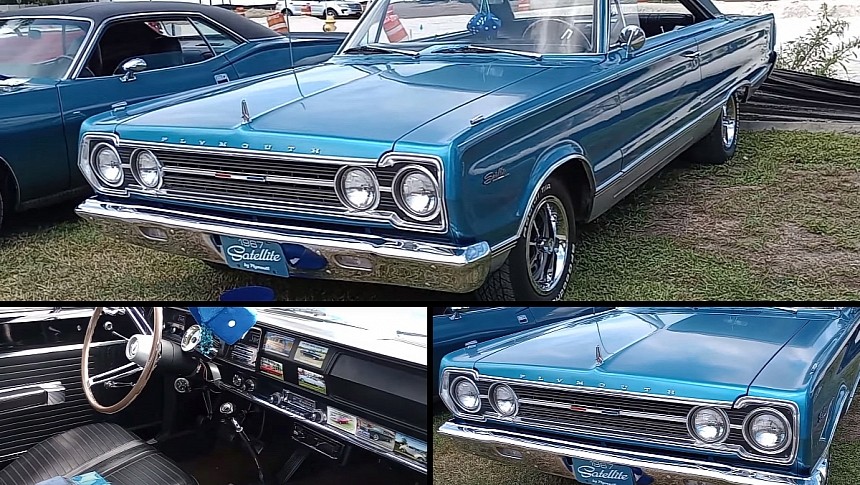Introduced in 1951 as a two-door hardtop version of the Cranbrook, the Plymouth Belvedere became a stand-alone nameplate in 1954. It was the company's bread-and-butter full-size automobile until 1962 when Plymouth moved the nameplate on the midsize B-body architecture.
The massive shift not only reduced the Belvedere's footprint but also spawned a series of new nameplates that became key players in the emerging muscle car market. I'm talking about the Road Runner, GTX, and Satellite.
The GTX arrived in 1967 as a premium offering restricted to two-door body styles and big-block V8 engines. It was followed by the similar yet more spartan and affordable Road Runner in 1968. The Satellite was introduced in 1964 and became the range-topping midsize until the GTX hit showroom floors.
Unlike the latter, the Satellite wasn't an exclusive big-block V8 affair. The two-door was also available with the smaller 273- and 318-cubic-inch (4.5- and 5.2-liter) mills. But it was among the first Mopars to get the 426-cubic-inch (7.0-liter) HEMI V8.
So, while it's not quite as famous as the GTX or the Road Runner in the muscle car realm, the Satellite is a fancied-up rig with sleeper credentials when fitted with a suitable powerplant. And this 1967 hardtop is the perfect proof.
Spotted at a local car show, this final-year first-generation Mopar is not a rare HEMI gem, but it's a stunning survivor sporting a spectacular shade of Medium Blue Poly. And even though the coating shines like it was recently applied, the mild patina suggests this Satellite is an unrestored survivor.
The interior is just as spectacular. Sure, black interiors aren't quite as striking as the white or blue upholstery options that Plymouth offered at the time, but everything looks flawless, from the dashboard to the "Satellite" logo insert in the upper rear seats. It may seem too pretty for a survivor, but look close enough, and you'll notice some wear and tear in certain areas, especially on the center console and the dash.
What's under the hood, you ask? As I said, this rig doesn't pack the rare and desirable 426 HEMI. But it's no slouch either because that plain hood hides a 383-cubic-inch (6.3-liter) big-block V8. The mill was available in two- and four-barrel formats. The former generated 270 horsepower, while the latter came with 335 horses on tap.
There's no info on whether this Satellite is a two- or four-barrel Mopar, but it features a four-speed manual for row-your-won fun. And that's all you need on a classic muscle car regardless of oomph. At least in my book.
Is the 1967 Satellite a rare classic? Well, rare isn't the word I'd use here, but it's not very common either. Plymouth sold 32,378 units that year, including 2,050 convertibles. This leaves 30,328 hardtops out there, but with many still rotting away in junkyards and barns, unmolested survivors like this Medium Blue example are hard to find. Check it out in the video below.
The GTX arrived in 1967 as a premium offering restricted to two-door body styles and big-block V8 engines. It was followed by the similar yet more spartan and affordable Road Runner in 1968. The Satellite was introduced in 1964 and became the range-topping midsize until the GTX hit showroom floors.
Unlike the latter, the Satellite wasn't an exclusive big-block V8 affair. The two-door was also available with the smaller 273- and 318-cubic-inch (4.5- and 5.2-liter) mills. But it was among the first Mopars to get the 426-cubic-inch (7.0-liter) HEMI V8.
So, while it's not quite as famous as the GTX or the Road Runner in the muscle car realm, the Satellite is a fancied-up rig with sleeper credentials when fitted with a suitable powerplant. And this 1967 hardtop is the perfect proof.
Spotted at a local car show, this final-year first-generation Mopar is not a rare HEMI gem, but it's a stunning survivor sporting a spectacular shade of Medium Blue Poly. And even though the coating shines like it was recently applied, the mild patina suggests this Satellite is an unrestored survivor.
The interior is just as spectacular. Sure, black interiors aren't quite as striking as the white or blue upholstery options that Plymouth offered at the time, but everything looks flawless, from the dashboard to the "Satellite" logo insert in the upper rear seats. It may seem too pretty for a survivor, but look close enough, and you'll notice some wear and tear in certain areas, especially on the center console and the dash.
What's under the hood, you ask? As I said, this rig doesn't pack the rare and desirable 426 HEMI. But it's no slouch either because that plain hood hides a 383-cubic-inch (6.3-liter) big-block V8. The mill was available in two- and four-barrel formats. The former generated 270 horsepower, while the latter came with 335 horses on tap.
There's no info on whether this Satellite is a two- or four-barrel Mopar, but it features a four-speed manual for row-your-won fun. And that's all you need on a classic muscle car regardless of oomph. At least in my book.
Is the 1967 Satellite a rare classic? Well, rare isn't the word I'd use here, but it's not very common either. Plymouth sold 32,378 units that year, including 2,050 convertibles. This leaves 30,328 hardtops out there, but with many still rotting away in junkyards and barns, unmolested survivors like this Medium Blue example are hard to find. Check it out in the video below.









